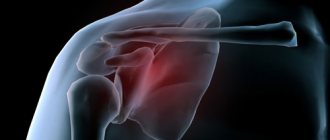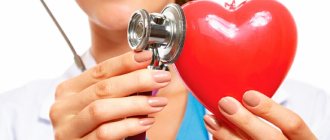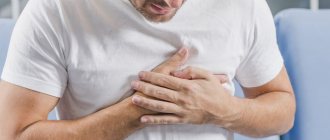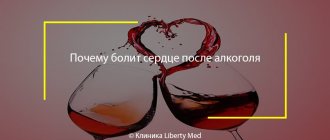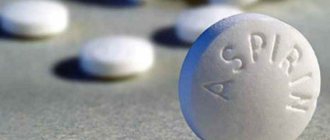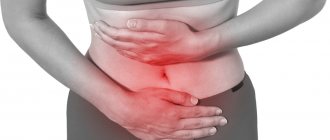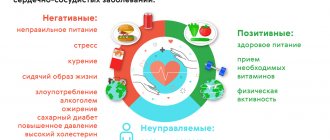How dangerous is heart pain?
Pain is a natural reaction of the body, designed to warn it about the development of a certain pathology.
The absence of an appropriate mechanism for a person would be fatal, since we would not feel anything and could die from household injuries. But what does pain in the heart area mean? This symptom alarms every person and is a cause for concern. And for good reason. According to statistics, diseases of the cardiovascular system confidently lead in the overall mortality structure of the population of the entire planet. Therefore, it is very important to differentiate the cause of chest pain in time to choose an adequate treatment method. Ignoring the symptom is contraindicated due to the risk of developing irreversible changes in the myocardium, which can be fatal.
Possible consequences of cardiac diseases accompanied by heart pain:
- necrosis (death) of individual cells or entire sections of the myocardium;
- progression of heart failure;
- the formation of cardiac aneurysms, which are sac-like protrusions of one of its walls;
- stagnation of blood in the lungs with the addition of symptoms such as cough, shortness of breath, deterioration in general health, etc.;
- heart rhythm disturbance.
However, don't panic prematurely. Pain in the heart area is not always a sign of myocardial infarction. There are a number of other pathologies that may have a similar clinical picture, but with a more favorable prognosis.
Etiology
Pain or discomfort in the chest area is a reason to consult a doctor. This is especially true for patients at high risk of developing a heart attack or other forms of coronary heart disease (CHD).
Factors contributing to the occurrence of the corresponding symptom:
- atherosclerotic lesions of the coronary vessels;
- overweight (you can calculate your body mass index here);
- smoking;
- chronic inflammatory processes in the body (tonsillitis, sinusitis, etc.);
- diseases of the peripheral nervous system.
These factors are mechanisms that trigger the pathogenetic mechanism of pain development. Depending on the individual characteristics of each organism, different intensity of the symptom is observed.
Mechanisms of chest pain:
- ischemia – a discrepancy between the need for oxygen for the operation of the main “pump” in the human body and the volume of its supply;
- inflammatory process of bacterial, viral or fungal origin;
- traumatic injury;
- neurological problems.
Depending on the mechanism of origin of the unpleasant symptom, its nature and the complaints with which the patient presents will differ. The doctor needs to quickly understand the situation to confirm or exclude life-threatening diagnoses and choose the optimal method of treating the person.
For example, if a patient comes to see me and complains that he has pain in his heart radiating to his left arm, I consider him first of all as a potential candidate for myocardial infarction. First, I need to exclude this diagnosis, and only after that can I carry out further differentiation in a calmer manner.
Common diseases
The most dangerous and common cause of pain in the chest area with migration to the arm remains myocardial infarction. The pathology is a form of coronary heart disease and annually claims millions of lives across the planet.
Characteristic signs of pain during a heart attack that everyone should remember:
- pronounced intensity (in 80% of cases);
- pressing or burning sensation. Patients sometimes say that “an elephant stepped on their chest”;
- duration more than 30 minutes;
- numbness or irradiation (spread) to the left arm, shoulder blade, corresponding half of the neck or jaw.
Patients with similar clinical symptoms are always urgently referred for specific diagnostics (ECG, blood test for troponin I, Echo-CG, coronary angiography) to verify the infarction and carry out appropriate treatment.
In addition to a heart attack, chest pain is often a consequence of the following diseases:
- Stable, variant and unstable angina. The principle of development of symptoms is the same as during a heart attack, but without myocardial necrosis.
- Pericarditis. Due to inflammation of the outer lining of the heart against the background of a bacterial, viral or fungal infection, specific receptors are irritated, which leads to the appearance of the symptom.
- Thoracic radiculitis. In this case, the pain in the heart is localized to a small area and has a stabbing nature. Noteworthy is the numbness of the hands and fingers, which develops due to compression of the nerve endings that emerge from the holes in the corresponding part of the spine.
- Myocarditis. The pain is less pronounced. Numbness of the hands in this case is much less common.
- Vegetovascular dystonia (VSD) (for more information about this condition, see the video below). Patients with this diagnosis almost always complain of heart pain. The sign may be accompanied by migration to the arm, but the severity of clinical symptoms is inferior to ischemic heart disease.
Timely diagnosis of the cause of acute pain will improve the prognosis for the patient and prevent the development of complications such as heart failure, fatal arrhythmias and myocardial ruptures.
Anatomy and functions of the shoulder joint
The shoulder joint is formed by the round head of the humerus and the glenoid cavity of the scapula. This joint connects the upper limb to the shoulder girdle. The head of the humerus is much larger than the glenoid cavity, which creates an increased range of motion in the joint. At the same time, the spherical head is sufficiently strengthened by increasing the depth of the articular cavity with a cartilaginous roller (which is also responsible for shock absorption) and muscle tendons, some of which pass inside the articular cavity.
From above, the articular joint is protected by an arch formed by the coracoid process of the scapula and the coracoacromial ligament. The synovial membrane forms branches (bursae, bursae) that improve the gliding process of articular surfaces.
This structure allows for a wide range of movements:
- flexion - movement of the arm forward and upward;
- extension – back and up;
- abduction – to the side and up;
- adduction – down to the body;
- pronation - rotation around the vertical axis of the lowered hand with the palm facing inward;
- supination - rotation around the vertical axis of the lowered arm with the palm outward;
- Roundabout Circulation.
Flexion and abduction of the arm above the horizontal position are carried out with participation in the movement of the shoulder girdle.
The structure of the shoulder joint
Expert advice
Chest discomfort is a symptom that should not be ignored.
If your heart hurts and the left side of your neck, arm, or shoulder blade goes numb, then you should immediately call an ambulance. Before the doctors arrive, I always recommend the following simple steps to my patients:
- Rest. You need to take a lying position and try to calm down.
- Access to fresh air. It is necessary to open the windows and remove oppressive clothing.
- Taking Nitroglycerin. Dose – 1 tablet under the tongue.
In 50-60% of cases, such an algorithm of actions will improve a person’s well-being and conduct an initial diagnosis of myocardial infarction. As cardiac muscle necrosis progresses, the pain and numbness of the left arm will not go away while taking nitroglycerin.
Rare diseases
The diseases described above remain the most common causes of acute chest pain with arm numbness. However, in my practice, I have encountered patients who, with (almost) similar symptoms, did not suffer from IHD or VSD.
Rare cardiac pathologies:
- "Broken Heart Syndrome" (Takotsubo). The pathology is accompanied by a sharp decrease in myocardial function due to stress. The clinic resembles a heart attack, but fatal complications do not develop.
- Mechanical damage. In this case, the cause-and-effect relationship between the chest injury and its symptoms is clearly visible.
- Oncological pathology. Heart tumors are a rare occurrence. However, when tumors grow into the pericardium, a corresponding clinical picture may occur.
Diagnostic methods
Without being a specialist, you cannot independently diagnose the disease and prescribe treatment for yourself. This could lead to the situation worsening to the point where nothing can be done. It is much better to consult a good doctor even when the first symptoms appear. Such specialists work at the St. Petersburg clinic “Energo”. Our doctors have extensive experience in solving problems with the musculoskeletal system and know what treatment to prescribe based on the current situation. The specialist will first examine you visually, collect anamnesis and conduct a palpation examination. This will allow you to find out the exact location of the pain and rule out a number of diseases. Then a referral will be given for tests and more informative studies, the most accurate of which is considered to be MRI
. However, if there is a fracture, a regular x-ray will be sufficient.
Clinical case
A 45-year-old man, an entrepreneur, was admitted to our clinic.
The patient complained of pressing pain in the chest radiating to the left side of the neck and arm. The symptom appeared suddenly after a quarrel with a customer. According to the patient, he initially decided to endure the discomfort, but after 2 hours of increasing pain he called an ambulance. The team doctors recorded an ECG, which showed a pathological Q wave and ST segment elevation. A man was admitted to us with a preliminary diagnosis of “Acute coronary syndrome”.
We urgently sent the patient to the catheterization laboratory for angiography. After identifying a total blockage of the anterior interventricular branch of the left coronary artery, a stent was installed in the patient at the site of occlusion with further prescription of drug therapy (beta blockers, antiplatelet agents, nitrates, statites) in adequate doses. Already on the second day, the man’s condition improved.
Prevention
To avoid neck problems, you need to lead an active lifestyle. If you work in an office, be sure to take a break every hour and a half. Lack of physical activity provokes not only neck pain, but also diseases of other organs. Therefore, try to walk at least 30 minutes a day, go to the gym if possible, or do exercises at home. As for nutrition, it is recommended to consume foods rich in calcium, and then diseases of the musculoskeletal system will bypass you. Eat more vegetables and fruits, be sure to include milk and fermented milk products in your diet: hard cheeses, kefir, Greek yogurt. If necessary, take dietary supplements - they will help achieve optimal daily calcium intake - but only after consulting with your doctor.

